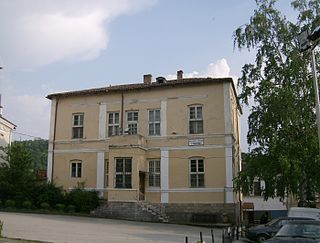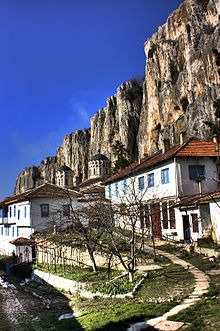
The Monastery of Saint Ivan of Rila, better known as the Rila Monastery is the largest and most famous Eastern Orthodox monastery in Bulgaria. It is situated in the southwestern Rila Mountains, 117 km (73 mi) south of the capital Sofia in the deep valley of the Rilska River at an elevation of 1,147 m (3,763 ft) above sea level, inside of Rila Monastery Nature Park. The monastery is named after its founder, the hermit Ivan of Rila, and houses around 60 monks.

The Bachkovo Monastery of the Dormition of the Theotokos, archaically the Petritsoni Monastery or Monastery of the Mother of God Petritzonitissa is a major Eastern Orthodox monastery in Southern Bulgaria. It is located on the right bank of the Chepelare River, 189 km from Sofia and 10 km south of Asenovgrad, and is directly subordinate to the Holy Synod of the Bulgarian Orthodox Church. The monastery is known and appreciated for the unique combination of Byzantine, Georgian and Bulgarian culture, united by the common faith.

Ivan Shishman ruled as emperor (tsar) of Bulgaria in Tarnovo from 1371 to 3 June 1395. The authority of Ivan Shishman was limited to the central parts of the Bulgarian Empire.

Saint Euthymius of Tarnovo was Patriarch of Bulgaria between 1375 and 1393. Regarded as one of the most important figures of medieval Bulgaria, Euthymius was the last head of the Bulgarian Orthodox Church in the Second Bulgarian Empire. Arguably the best esteemed of all Bulgarian patriarchs, Euthymius was a supporter of hesychasm and an authoritative figure in the Eastern Orthodox world of the time.

Tsarevets is a medieval stronghold located on a hill with the same name in Veliko Tarnovo in northern Bulgaria. Tsarevets is 206 metres (676 ft) above sea level.It served as the Second Bulgarian Empire's primary fortress and strongest bulwark from 1185 to 1393, housing the royal and the patriarchal palaces, and is a popular tourist attraction.

Zahariy Hristovich Dimitrov (1810–1853), better known as Zahari Zograf is arguably the most famous Bulgarian painter of the Bulgarian National Revival, noted for his church mural paintings and icons and often regarded as the founder of secular art in Bulgaria due to the introduction of everyday life elements in his work.
Holy Trinity monastery is the title of several Christian monasteries, including (sorted by the country):
The Holy Venerable Theodosius of Tarnovo was a high-ranking 14th-century Bulgarian cleric and hermit and the person credited with establishing hesychasm in the Second Bulgarian Empire. A disciple of Gregory of Sinai, Theodosius founded the Kilifarevo monastery and school near the then-Bulgarian capital Tarnovo and took an important part in the condemning of various heresies during the reign of Tsar Ivan Alexander of Bulgaria.

Dragalevtsi Monastery of the Holy Mother of God of Vitosha is a Bulgarian Orthodox monastery on the lower slopes of Vitosha mountain on the outskirts of the capital Sofia in western Bulgaria. Founded in the mid-14th century by Bulgarian tsar Ivan Alexander, the monastery was abandoned after the Ottoman conquest of Sofia and reestablished in the late 15th century, when it became an important literary centre. The monastery church and some of its frescoes date from this period.

The Church of Saints Peter and Paul is a medieval Bulgarian Orthodox church in the city of Veliko Tarnovo in central northern Bulgaria, the former capital of the Second Bulgarian Empire. The 13th-century church lies at the foot of the Tsarevets hill's northern slopes and was reconstructed in 1981.

The Patriarchal Cathedral of the Holy Ascension of God is a former Eastern Orthodox cathedral in the city of Veliko Tarnovo, in north central Bulgaria. Located on top of the fortified Tsarevets hill in the former capital of the Second Bulgarian Empire, the cathedral was the seat of the Bulgarian patriarch from its construction in the 11th–12th century to its destruction in 1393.
This is a list of people, places, and events related to the medieval Bulgarian Empires — the First Bulgarian Empire (681–1018), and the Second Bulgarian Empire (1185–1396).

The Etropole Monastery of the Holy Trinity, also known as Varovitets (Варовитец), is a Bulgarian Orthodox monastery near the town of Etropole in west-central Bulgaria. The monastery was founded in the 12th or 13th century, its heyday being from the 16th to the 18th century when, thanks to its prolific scriptoria, it was the dominant literary centre of Ottoman-ruled northern Bulgaria. In its present form, the monastery includes a large mid-19th-century church and two chapels.

The Tаrnovo Patriarchate was the name of the independent Bulgarian Orthodox Church in the period 1235-1393.
Sveta gora is a hill in Tarnovgrad and was spiritual and literary center in the Second Bulgarian Empire.

Eparchy of Veliko Tarnovo is one of the eparchies of the Bulgarian Orthodox Church in the Bulgaria.
























